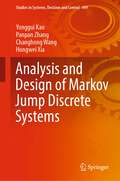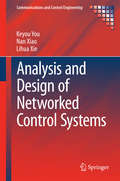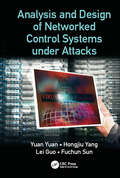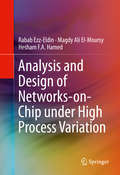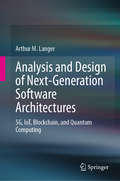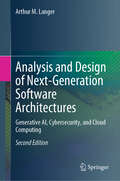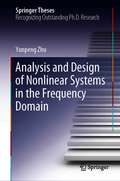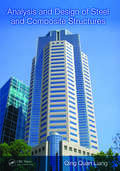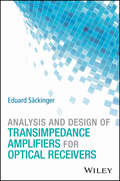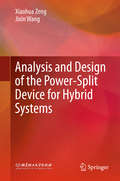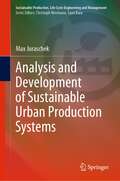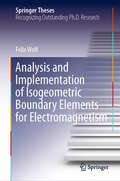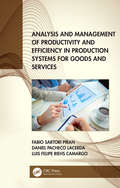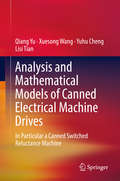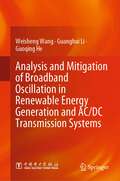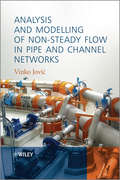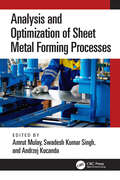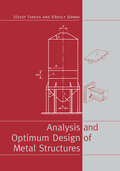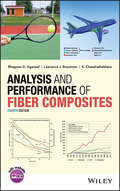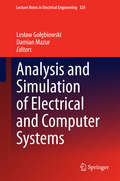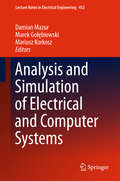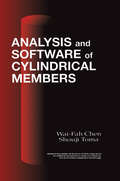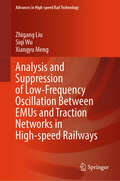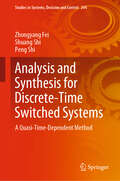- Table View
- List View
Analysis and Design of Markov Jump Discrete Systems (Studies in Systems, Decision and Control #499)
by Yonggui Kao Panpan Zhang Changhong Wang Hongwei XiaThis book proposes analysis and design techniques for Markov jump systems (MJSs) using Lyapunov function and sliding mode control techniques. It covers a range of topics including stochastic stability, finite-time boundedness, actuator-fault problem, bumpless transfer scheme, and adaptive sliding mode fault-tolerant control for uncertain MJSs. Notably, the book presents a new model for deception attacks (DAs), establishing the correlation between attacks and time delays, which should be of particular interest due to the recent increase in such attacks. The book's content is presented in a comprehensive, progressive manner, with fundamental principles introduced first before addressing more advanced techniques. The book features illustrations and tables, providing readers with a practical and intuitive approach to applying these methods in their own research. This book will prove invaluable to researchers and graduate students in control engineering and applied mathematics with an interest in the latest developments in MJSs.
Analysis and Design of Networked Control Systems (Communications and Control Engineering)
by Keyou You Nan Xiao Lihua XieThis monograph focuses on characterizing the stability and performance consequences of inserting limited-capacity communication networks within a control loop. The text shows how integration of the ideas of control and estimation with those of communication and information theory can be used to provide important insights concerning several fundamental problems such as: · minimum data rate for stabilization of linear systems over noisy channels; · minimum network requirement for stabilization of linear systems over fading channels; and · stability of Kalman filtering with intermittent observations. A fundamental link is revealed between the topological entropy of linear dynamical systems and the capacities of communication channels. The design of a logarithmic quantizer for the stabilization of linear systems under various network environments is also extensively discussed and solutions to many problems of Kalman filtering with intermittent observations are demonstrated. Analysis and Design of Networked Control Systems will interest control theorists and engineers working with networked systems and may also be used as a resource for graduate students with backgrounds in applied mathematics, communications or control who are studying such systems.
Analysis and Design of Networked Control Systems under Attacks
by Fuchun Sun Yuan Yuan Hongjiu Yang Lei GuoThis book adopts a systematic view of the control systems in cyber-physical systems including the security control of the optimal control system, security control of the non-cooperative game system, quantify the impact of the Denial-of-Service attacks on the optimal control system, and the adaptive security control of the networked control systems. Because the cyber-physical system is a hybrid system, it adopts cross layer approach to handle the security control of the CPS. It presents a number of attack models according to the attack scenario and defense facilities, and a number of cross-layer co-design methodologies to secure the control of CPS.
Analysis and Design of Networks-on-Chip Under High Process Variation
by Rabab Ezz-Eldin Magdy Ali El-Moursy Hesham F. A. HamedThis book describes in detail the impact of process variations on Network-on-Chip (NoC) performance. The authors evaluate various NoC topologies under high process variation and explain the design of efficient NoCs, with advanced technologies. The discussion includes variation in logic and interconnect, in order to evaluate the delay and throughput variation with different NoC topologies. The authors describe an asynchronous router, as a robust design to mitigate the impact of process variation in NoCs and the performance of different routing algorithms is determined with/without process variation for various traffic patterns. Additionally, a novel Process variation Delay and Congestion aware Routing algorithm (PDCR) is described for asynchronous NoC design, which outperforms different adaptive routing algorithms in the average delay and saturation throughput for various traffic patterns.
Analysis and Design of Next-Generation Software Architectures: 5G, IoT, Blockchain, and Quantum Computing
by Arthur M. LangerThis book provides a detailed “how-to” guide, addressing aspects ranging from analysis and design to the implementation of applications, which need to be integrated within legacy applications and databases.The analysis and design of the next generation of software architectures must address the new requirements to accommodate the Internet of things (IoT), cybersecurity, blockchain networks, cloud, and quantum computer technologies. As 5G wireless increasingly establishes itself over the next few years, moving legacy applications into these new architectures will be critical for companies to compete in a consumer-driven and social media-based economy. Few organizations, however, understand the challenges and complexities of moving from a central database legacy architecture to a ledger and networked environment.The challenge is not limited to just designing new software applications. Indeed, the next generation needs to function more independently on various devices, and on more diverse and wireless-centric networks. Furthermore, databases must be broken down into linked list-based blockchain architectures, which will involve analytic decisions regarding which portions of data and metadata will be processed within the chain, and which ones will be dependent on cloud systems. Finally, the collection of all data throughout these vast networks will need to be aggregated and used for predictive analysis across a variety of competitive business applications in a secured environment. Certainly not an easy task for any analyst/designer!Many organizations will continue to use packaged products and open-source applications. These third-party products will need to be integrated into the new architecture paradigms and have seamless data aggregation capabilities, while maintaining the necessary cyber compliances. The book also clearly defines the roles and responsibilities of the stakeholders involved, including the IT departments, users, executive sponsors, and third-party vendors. The book’s structure also provides a step-by-step method to help ensure a higher rate of success in the context of re-engineering existing applications and databases, as well as selecting third-party products, conversion methods and cybercontrols. It was written for use by a broad audience, including IT developers, software engineers, application vendors, business line managers, and executives.
Analysis and Design of Next-Generation Software Architectures: Generative AI, Cybersecurity, and Cloud Computing
by Arthur M. LangerThe 2nd edition will add a major chapter on Generative AI in Software Architecture. This chapter will provide a comprehensive background in generative models, its impact on software design, evolution of new analysis methodologies, and the overall impact of the Systems Development Life Cycle (SDLC). The new edition will also have new sections relating to Generative AI in Cybersecurity analysis and design, including proactive threat detection, ethical issues regarding privacy, and generative AI workflows (Charlotte AI). Other updates include Legacy System interfaces with Generative AI, new impacts on project management, and Platform design architecture. The 2nd edition will have a number of editing changes and corrections, as well as about 30 pages net of some eliminations of outdated content.
Analysis and Design of Nonlinear Systems in the Frequency Domain (Springer Theses)
by Yunpeng ZhuThis book focuses on the development of three novel approaches to build up a framework for the frequency domain analysis and design of nonlinear systems. The concepts are derived from Volterra series representation of nonlinear systems which are described by nonlinear difference or differential equations. Occupying the middle ground between traditional linear approaches and more complex nonlinear system theories, the book will help readers to have a good start to analyse and exploit the nonlinearities. Analysis and Design of Nonlinear Systems in the Frequency Domain provides clear illustrations and examples at the beginning and the end of each chapter, respectively, making it of interest to both academics and practicing engineers.
Analysis and Design of Steel and Composite Structures
by Qing Quan LiangSteel and composite steel–concrete structures are widely used in modern bridges, buildings, sport stadia, towers, and offshore structures. Analysis and Design of Steel and Composite Structures offers a comprehensive introduction to the analysis and design of both steel and composite structures. It describes the fundamental behavior of steel and composite members and structures, as well as the current design criteria and procedures given in Australian standards AS/NZS 1170, AS 4100, AS 2327.1, Eurocode 4, and AISC-LRFD specifications.Featuring numerous step-by-step examples that clearly illustrate the detailed analysis and design of steel and composite members and connections, this practical and easy-to-understand text: Covers plates, members, connections, beams, frames, slabs, columns, and beam-columns Considers bending, axial load, compression, tension, and design for strength and serviceability Incorporates the author’s latest research on composite members Analysis and Design of Steel and Composite Structures is an essential course textbook on steel and composite structures for undergraduate and graduate students of structural and civil engineering, and an indispensable resource for practising structural and civil engineers and academic researchers. It provides a sound understanding of the behavior of structural members and systems.
Analysis and Design of Steel and Composite Structures
by Qing Quan LiangSteel and composite steel–concrete structures are widely used in modern bridges, buildings, sport stadia, towers, and offshore structures. Analysis and Design of Steel and Composite Structures offers a comprehensive introduction to the analysis and design of both steel and composite structures. It describes the fundamental behavior of steel and composite members and structures, as well as the current design criteria and procedures given in Australian standards AS/NZS 1170, AS 4100, AS 2327.1, Eurocode 4, and AISC-LRFD specifications.Featuring numerous step-by-step examples that clearly illustrate the detailed analysis and design of steel and composite members and connections, this practical and easy-to-understand text: Covers plates, members, connections, beams, frames, slabs, columns, and beam-columns Considers bending, axial load, compression, tension, and design for strength and serviceability Incorporates the author’s latest research on composite members Analysis and Design of Steel and Composite Structures is an essential course textbook on steel and composite structures for undergraduate and graduate students of structural and civil engineering, and an indispensable resource for practising structural and civil engineers and academic researchers. It provides a sound understanding of the behavior of structural members and systems.
Analysis and Design of Transimpedance Amplifiers for Optical Receivers
by Eduard SäckingerAn up-to-date, comprehensive guide for advanced electrical engineering studentsand electrical engineers working in the IC and optical industries This book covers the major transimpedance amplifier (TIA) topologies and their circuit implementations for optical receivers. This includes the shunt-feedback TIA, common-base TIA, common-gate TIA, regulated-cascode TIA, distributed-amplifier TIA, nonresistive feedback TIA, current-mode TIA, burst-mode TIA, and analog-receiver TIA. The noise, transimpedance, and other performance parameters of these circuits are analyzed and optimized. Topics of interest include post amplifiers, differential vs. single-ended TIAs, DC input current control, and adaptive transimpedance. The book features real-world examples of TIA circuits for a variety of receivers (direct detection, coherent, burst-mode, etc.) implemented in a broad array of technologies (HBT, BiCMOS, CMOS, etc.). The book begins with an introduction to optical communication systems, signals, and standards. It then moves on to discussions of optical fiber and photodetectors. This discussion includes p-i-n photodetectors; avalanche photodetectors (APD); optically preamplified detectors; integrated detectors, including detectors for silicon photonics; and detectors for phase-modulated signals, including coherent detectors. This is followed by coverage of the optical receiver at the system level: the relationship between noise, sensitivity, optical signal-to-noise ratio (OSNR), and bit-error rate (BER) is explained; receiver impairments, such as intersymbol interference (ISI), are covered. In addition, the author presents TIA specifications and illustrates them with example values from recent product data sheets. The book also includes: Many numerical examples throughout that help make the material more concrete for readers Real-world product examples that show the performance of actual IC designs Chapter summaries that highlight the key points Problems and their solutions for readers who want to practice and deepen their understanding of the material Appendices that cover communication signals, eye diagrams, timing jitter, nonlinearity, adaptive equalizers, decision point control, forward error correction (FEC), and second-order low-pass transfer functions Analysis and Design of Transimpedance Amplifiers for Optical Receivers belongs on the reference shelves of every electrical engineer working in the IC and optical industries. It also can serve as a textbook for upper-level undergraduates and graduate students studying integrated circuit design and optical communication.
Analysis and Design of the Power-Split Device for Hybrid Systems
by Xiaohua Zeng Jixin WangThis book presents a comprehensive overview of power-split device (PSD) design. It discusses vehicle energy consumption characteristics, hybrid vehicle power request solutions, typical configurations, operating principle and simulation technology of PSD hybrid system, a multi-factor integrated parametric design method and a dynamic coordinated control method for PSD hybrid system. It also describes the finite element analysis, thermal analysis and optimization of the PSD based on a surrogate model, explains the theory behind the design and the simulation, and provides concrete examples. It is a valuable resource for researchers and the engineers to gain a better understanding of the PSD design process.
Analysis and Development of Sustainable Urban Production Systems (Sustainable Production, Life Cycle Engineering and Management)
by Max JuraschekManufacturing of products in urban production sites is connected to unique potentials, yet also to specific challenges. Urban factories can provide functional diversity and contribute positive impacts to a city. The concept of urban production receives rising attention in research and industry and it is recognized in its interdisciplinary nature. With a holistic approach from both the urban perspective and the factory perspective, negative impacts can be minimized, positive effects enabled and mutually beneficial, symbiotic combinations created. The presented framework and methods for the evaluation and implementation of sustainable urban production systems allow the assessment of impacts and provide the means to control and utilize the unique strengths of urban factories for cities and industry. This will allow a structured derivation of methods and measures from the concept of urban production for producing enterprises and the urban stakeholders.
Analysis and Implementation of Isogeometric Boundary Elements for Electromagnetism (Springer Theses)
by Felix WolfThis book presents a comprehensive mathematical and computational approach for solving electromagnetic problems of practical relevance, such as electromagnetic scattering and the cavity problems. After an in-depth introduction to the mathematical foundations of isogeometric analysis, which discusses how to conduct higher-order simulations efficiently and without the introduction of geometrical errors, the book proves quasi-optimal approximation properties for all trace spaces of the de Rham sequence, and demonstrates inf-sup stability of the isogeometric discretisation of the electric field integral equation (EFIE). Theoretical properties and algorithms are described in detail. The algorithmic approach is, in turn, validated through a series of numerical experiments aimed at solving a set of electromagnetic scattering problems. In the last part of the book, the boundary element method is combined with a novel eigenvalue solver, a so-called contour integral method. An algorithm is presented, together with a set of successful numerical experiments, showing that the eigenvalue solver benefits from the high orders of convergence offered by the boundary element approach. Last, the resulting software, called BEMBEL (Boundary Element Method Based Engineering Library), is reviewed: the user interface is presented, while the underlying design considerations are explained in detail. Given its scope, this book bridges an important gap between numerical analysis and engineering design of electromagnetic devices.
Analysis and Management of Productivity and Efficiency in Production Systems for Goods and Services
by Daniel Pacheco Lacerda Fabio Sartori Piran Luis Felipe CamargoIn companies that produce goods and services, productivity and efficiency improvements are a constant challenge. This book reviews the differences between productivity and efficiency. It proposes a new method and makes available a computational tool for implementation that contributes to facilitating the use of Data Envelopment Analysis (DEA). The book presents a discussion about productivity and efficiency, illustrating the potentials of use and conceptual differences. It covers the concepts and techniques for analysis of productivity and efficiency, analyzing critical benefits and limitations, explains in detail how to use DEA for analysis, provides innovative methods for using DEA, offers a free online computer tool with a direction guide, shows real empirical applications, and covers other techniques that can be used to complement the analysis performed. The book is for professionals, managers, consultants, students working and taking courses in productive systems of goods and services. Ancillary materials include a free online computer tool to operationalize the concepts and methods proposed in the book, a guide on how to use the method and the software developed for the DEA application. Solutions manual, instructor’s manual, PowerPoint slides, and figure slides also will be available upon qualified adoption.
Analysis and Mathematical Models of Canned Electrical Machine Drives: In Particular a Canned Switched Reluctance Machine
by Qiang Yu Xuesong Wang Yuhu Cheng Lisi TianThis book focuses on the electromagnetic and thermal modeling and analysis of electrical machines, especially canned electrical machines for hydraulic pump applications. It addresses both the principles and engineering practice, with more weight placed on mathematical modeling and theoretical analysis. This is achieved by providing in-depth studies on a number of major topics such as: can shield effect analysis, machine geometry optimization, control analysis, thermal and electromagnetic network models, magneto motive force modeling, and spatial magnetic field modeling. For the can shield effect analysis, several cases are studied in detail, including classical canned induction machines, as well as state-of-the-art canned permanent magnet machines and switched reluctance machines. The comprehensive and systematic treatment of the can effect for canned electrical machines is one of the major features of this book, which is particularly suited for readers who are interested in learning about electrical machines, especially for hydraulic pumping, deep-sea exploration, mining and the nuclear power industry. The book offers a valuable resource for researchers, engineers, and graduate students in the fields of electrical machines, magnetic and thermal engineering, etc.
Analysis and Mitigation of Broadband Oscillation in Renewable Energy Generation and AC/DC Transmission Systems
by Guanghui Li Weisheng Wang Guoqing HeWith the growth of the installed capacity and the proportion of REG, mainly including wind power and PV power generation, the stable operation of REG and AC/DC transmission systems has become a technical bottleneck for the sustainable development of REG. Since 2009, broadband oscillation incidents have occurred frequently in REG and AC/DC transmission systems in China and some foreign countries, resulting in severe consequences such as large-scale tripping-off of REG units, damaging equipments, and an increasing curtailment of wind and PV power generation. However, there are great difficulties and challenges for the analysis and mitigation of broadband oscillation.This book focuses on the analysis and mitigation of broadband oscillation in renewable energy generation and AC/DC transmission systems. The theoretical knowledge and practical approaches to solve this issue are explored through the contents of 4 parts, 18 chapters. Part Ⅰ is Small-signal Modeling of Converters, containing four chapters. The frequency-domain small-signal modeling method and impedance modeling of three types of basic converters commonly used in power electronic devices, including the two-level converter, modular multilevel converter, and thyristor converter are introduced. Part Ⅱ is Impedance Model and Characteristics Analysis of REG and HVDC Transmission, containing six chapters. The impedance model and characteristics analysis of the full power conversion wind turbine, DFIG-based wind turbines, PV unit, SVG, LCC-HVDC, and MMC-HVDC are introduced. Part Ⅲ is Broadband Oscillation Analysis in REG and AC/DC Transmission Systems, containing three chapters. The impedance modeling and characteristics analysis of REG plants, and oscillation analysis of REG connected into AC and HVDC transmission systems are introduced. Part Ⅳ is Broadband Oscillation Mitigation in REG and AC/DC Transmission Systems, containing five chapters. The impedance reshaping of the REG unit, SVG, LCC-HVDC, and MMC-HVDC as well as project cases are presented.This book can be used by the researchers engaged in the design, technology research and development, and operation management of electrical engineering and renewable energy engineering, which can also be a reference book for teachers and students of electrical engineering in colleges and universities.
Analysis and Modelling of Non-Steady Flow in Pipe and Channel Networks
by Vinko JovicAnalysis and Modelling of Non-Steady Flow in Pipe and Channel Networks deals with flows in pipes and channel networks from the standpoints of hydraulics and modelling techniques and methods. These engineering problems occur in the course of the design and construction of hydroenergy plants, water-supply and other systems. In this book, the author presents his experience in solving these problems from the early 1970s to the present day. During this period new methods of solving hydraulic problems have evolved, due to the development of computers and numerical methods. This book is accompanied by a website which hosts the author's software package, Simpip (an abbreviation of simulation of pipe flow) for solving non-steady pipe flow using the finite element method. The program also covers flows in channels. The book presents the numerical core of the SimpipCore program (written in Fortran). Key features: Presents the theory and practice of modelling different flows in hydraulic networks Takes a systematic approach and addresses the topic from the fundamentals Presents numerical solutions based on finite element analysis Accompanied by a website hosting supporting material including the SimpipCore project as a standalone program Analysis and Modelling of Non-Steady Flow in Pipe and Channel Networks is an ideal reference book for engineers, practitioners and graduate students across engineering disciplines.
Analysis and Optimization of Sheet Metal Forming Processes
by Amrut Mulay Swadesh Kumar Singh Andrzej KocandaAnalysis and Optimization of Sheet Metal Forming Processes comprehensively covers sheet metal forming, from choosing materials, tools and the forming method to optimising the entire process through finite element analysis and computer-aided engineering.Beginning with an introduction to sheet metal forming, the book provides a guide to the various techniques used within the industry. It provides a discussion of sheet metal properties relevant to forming processes, such as ductility, formability, and strength, and analyses how materials should be selected with factors including material properties, cost, and availability. Forming processes including shearing, bending, deep drawing, and stamping are also discussed, along with tools such as dies, punches, and moulds. Simulation and modelling are key to optimising the sheet metal forming process, including finite element analysis and computer-aided engineering. Other topics included are quality control, design, industry applications, and future trends. The book will be of interest to students and professionals working in the field of sheet metal and metal forming, materials science, mechanical engineering, and metallurgy.
Analysis and Optimum Design of Metal Structures
by J Farkas K. JármaiDetailing a number of structural analysis problems such as residual welding stresses and distortions and behaviour of thin-walled rods loaded in bending, this text also explores mathematical function minimization methods, expert systems and optimum design of welded box beams.
Analysis and Performance of Fiber Composites
by Bhagwan D. Agarwal Lawrence J. Broutman K. ChandrashekharaUpdated and expanded coverage of the latest trends and developments in fiber composite materials, processes, and applications Analysis and Performance of Fiber Composites, Fourth Edition features updated and expanded coverage of all technical aspects of fiber composites, including the latest trends and developments in materials, manufacturing processes, and materials applications, as well as the latest experimental characterization methods. Fiber reinforced composite materials have become a fundamental part of modern product manufacturing. Routinely used in such high-tech fields as electronics, automobiles, aircraft, and space vehicles, they are also essential to everyday staples of modern life, such as containers, piping, and appliances. Little wonder, when one considers their ease of fabrication, outstanding mechanical properties, design versatility, light weight, corrosion and impact resistance, and excellent fatigue strength. This Fourth Edition of the classic reference—the standard text for composite materials courses, worldwide—offers an unrivalled review of such an important class of engineering materials. Still the most comprehensive, up-to-date treatment of the mechanics, materials, performance, analysis, fabrication, and characterization of fiber composite materials available, Analysis and Performance of Fiber Composites, Fourth Edition features: Expanded coverage of materials and manufacturing, with additional information on materials, processes, and material applications Updated and expanded information on experimental characterization methods—including many industry specific tests Discussions of damage identification techniques using nondestructive evaluation (NDE) Coverage of the influence of moisture on performance of polymer matrix composites, stress corrosion of glass fibers and glass reinforced plastics, and damage due to low-velocity impact New end-of-chapter problems and exercises with solutions found on an accompanying website Computer analysis of laminates No other reference provides such exhaustive coverage of fiber composites with such clarity and depth. Analysis and Performance of Fiber Composites, Fourth Edition is, without a doubt, an indispensable resource for practicing engineers, as well as students of mechanics, mechanical engineering, and aerospace engineering.
Analysis and Simulation of Electrical and Computer Systems (Lecture Notes in Electrical Engineering #324)
by Lesław Gołębiowski Damian MazurThis book presents the selected results of the XI Scientific Conference Selected Issues of Electrical Engineering and Electronics (WZEE) which was held in Rzeszów and Czarna, Poland on September 27-30, 2013. The main aim of the Conference was to provide academia and industry to discuss and present the latest technological advantages and research results and to integrate the new interdisciplinary scientific circle in the field of electrical engineering, electronics and mechatronics. The Conference was organized by the Rzeszów Division of Polish Association of Theoretical and Applied Electrical Engineering (PTETiS) in cooperation with Rzeszów University of Technology, the Faculty of Electrical and Computer Engineering and Rzeszów University, the Faculty of Mathematics and Natural Sciences.
Analysis and Simulation of Electrical and Computer Systems (Lecture Notes in Electrical Engineering #452)
by Damian Mazur Marek Gołębiowski Mariusz KorkoszThis book addresses selected topics in electrical engineering, electronics and mechatronics that have posed serious challenges for both the scientific and engineering communities in recent years. The topics covered range from mathematical models of electrical and electronic components and systems, to simulation tools implemented for their analysis and further developments; and from multidisciplinary optimization, signal processing methods and numerical results, to control and diagnostic techniques. By bridging theory and practice in the modeling, design and optimization of electrical, electromechanical and electronic systems, and by adopting a multidisciplinary perspective, the book provides researchers and practitioners with timely and extensive information on the state of the art in the field - and a source of new, exciting ideas for further developments and collaborations.
Analysis and Software of Cylindrical Members (New Directions In Civil Engineering Ser.)
by W.F. Chen Shouji TomaThis book provides an in-depth look at the behavior, design, and construction of offshore structures. It describes the behavior of cylindrical members and suggests appropriate software, written by the contributors, to determine everything from loading up to the ultimate load, including post-buckling and cyclic inelasticity.
Analysis and Suppression of Low-Frequency Oscillation Between EMUs and Traction Networks in High-speed Railways (Advances in High-speed Rail Technology)
by Zhigang Liu Siqi Wu Xiangyu MengThis book focuses on the low-frequency oscillation between EMUs and traction networks in high-speed Railways. As the power source of high-speed trains, the traction network's power performance directly affects the safe and stable operation of the train. However, the low-frequency oscillation between EMUs and traction networks will fluctuate voltage or current, resulting in poor power quality, electrical device failure, and even interruption of traction power. Therefore, it is important to reveal the mechanism of low-frequency oscillation and propose suppression strategies. This book systematically shows the newest research results of analysis and suppression of low-frequency oscillation between EMUs and traction networks in high-speed railways, especially in the modeling methods of vehicle-grid systems and suppression strategies for low-frequency oscillation. These methods or strategies can provide important references and help for researchers, scholars, and engineers on traction power technology in high-speed railways. The main contents include the overview of low-frequency oscillation between EMUs and traction networks, the introduction of main modeling methods for vehicle-grid systems, especially single-phase rectifiers, the line-side converter control algorithms in vehicles for the suppression of low-frequency oscillation, the traction substation power compensation strategies for the suppression of low-frequency oscillation, etc.
Analysis and Synthesis for Discrete-Time Switched Systems: A Quasi-Time-Dependent Method (Studies in Systems, Decision and Control #244)
by Peng Shi Zhongyang Fei Shuang ShiThis book presents recent theoretical advances in the analysis and synthesis of discrete-time switched systems under the time-dependent switching scheme, including stability and disturbance attenuation performance analysis, control and filtering, asynchronous switching, finite-time analysis and synthesis, and reachable set estimation. It discusses time-scheduled technology, which can achieve a better performance and reduce conservatism compared with the traditional time-independent approach. Serving as a reference resource for researchers and engineers in the system and control community, it is also useful for graduate and undergraduate students interested in switched systems and their applications.
